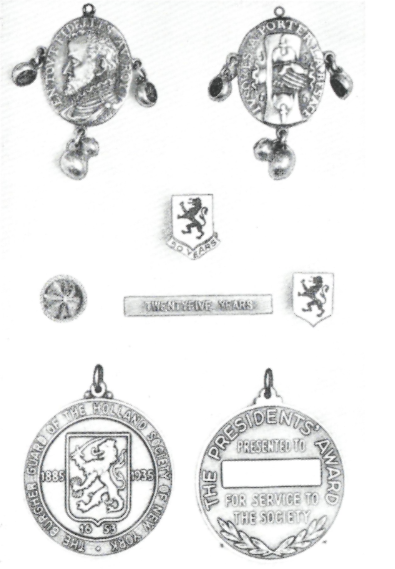Few Societies possess insignia comparable in historical significance to that of the Holland Society. From the famous “Beggars’ Medal” or ceremonial badge, the devices indicative of long membership and lapel insignia, to the newly established “Presidents’ Award” — all have special and cherished meaning. As shown in the accompanying illustration (which omits ribbons), each is slightly reduced in size.
Ceremonial Badge: The “Beggars’ Medal” is a memorial of the first steps of that march toward civil and religious liberty in which the Dutch people, after epic struggles, led the world. Based on plaster casts from the Museum of Antiquities, Amsterdam, and adopted by the Society on March 30, 1887, the badge is appropriately worn on ceremonial occasions by their descendants, who in America have received in largest measure the benefits of that noble conflict.
Features of this famous genze-n penning relate back to 1566. Philip II then had determined to force Inquisition and certain innovations upon the Low Countries, an action which the Dutch vehemently protested to Margaret of Parma, king’s regent in the Netherlands. When Dutch notables came before her to remonstrate, the Duchess appeared disturbed, whereupon one of her courtiers remarked, Ceux ne soni cine des giienx (They are only beggars). The dispute becoming irreconcilable, tyranny against men’s liberties, the Dutch revolt began in which the livery of beggars — wallet, bowl and bottle-gourd — became and always remained identified with the patriot cause.
A revealing facet of Dutch character is disclosed in the medal’s motto. On the face appears an armed bust of Philip II with the words, En tout fidelles an Roy (faithful to the king), and on the reverse with beggars’ insignia, Jusques a porter la hesace (even to carrying the wallet). That is to say, the law-abiding Dutch, while adhering to their allegiance, still had to rebel regardless of cost against those who created mistaken royal policy. The Society’s medal, a triumph of medallic art, can be supplied to members in silver or in gold, or in miniature.
For long-term members are the “Fifty-Year Emblem,” and Twenty-Five Year Bar to the ceremonial badge. A token of high esteem, the Emblem is awarded with fitting ceremony at the Annual Banquet when a member attains his 50th year on the roster. Of 10-karat gold, it carries the words “50 Years” on a metallic scroll affixed to the Lion lapel pin. The Bar is obtainable upon attainment of 25 years as a member.
Lapel Insignia: Designed to be worn as evidence of continuing pride in membership, these emblems are of two kinds. The metal lapel pin depicts the Lion of Holland in red enamel upon a golden field. Extremely popular with members since 1897, when adopted by the Society, the pin is of 10-karat gold or silver gilt. The rosette, which the Main office has in stock, is a ribbon badge of moired orange silk. Also in wide use, it acts as a reminder of relation to the Dutch, with whom the orange hue has been long associated.
Guard Service Medal: The recently instituted “Presidents’ Award” is earned for outstanding merit demonstrated in serving the Society while a member of the Burgher Guard. Detailed and stringent criteria for the award appeared in the Burgher Guard Chronicle last June. Two-fold purpose of the medal is to act as an incentive in maintaining esprit de corps, and to confer visible evidence of appreciation for long service or notable achievement, or both. Recipients this month, for example, averaged 17 years service and included eight trustees and six Branch presidents.
From a heraldic standpoint, the medal obverse resembles the Dutch armorial device current during the war of liberation. It shows within a shield the Netherlands Lion rampant with upraised sword. In the lion’s other paw is a bundle of arrows symbolizing the provinces. Dates refer to founding of the Society (1885), establishing the Guard within the Society (1935), and Director Peter Stuyvesant’s organizing the Burgher Guard of New Amsterdam (1653).
 At top: The celebrated “Beggars’ Medal,” or ceremonial badge. Obverse (front) at left, reverse at right. Center group {from left to right): Lapel Rosette; 25-Year Bar, to badge; 50-Year Emblem (above Bar); Lapel Pin. At Bottom: “The Presidents’ Award,” or Burgher Guard Service Medal. Obverse at left, reverse at right.
At top: The celebrated “Beggars’ Medal,” or ceremonial badge. Obverse (front) at left, reverse at right. Center group {from left to right): Lapel Rosette; 25-Year Bar, to badge; 50-Year Emblem (above Bar); Lapel Pin. At Bottom: “The Presidents’ Award,” or Burgher Guard Service Medal. Obverse at left, reverse at right.

